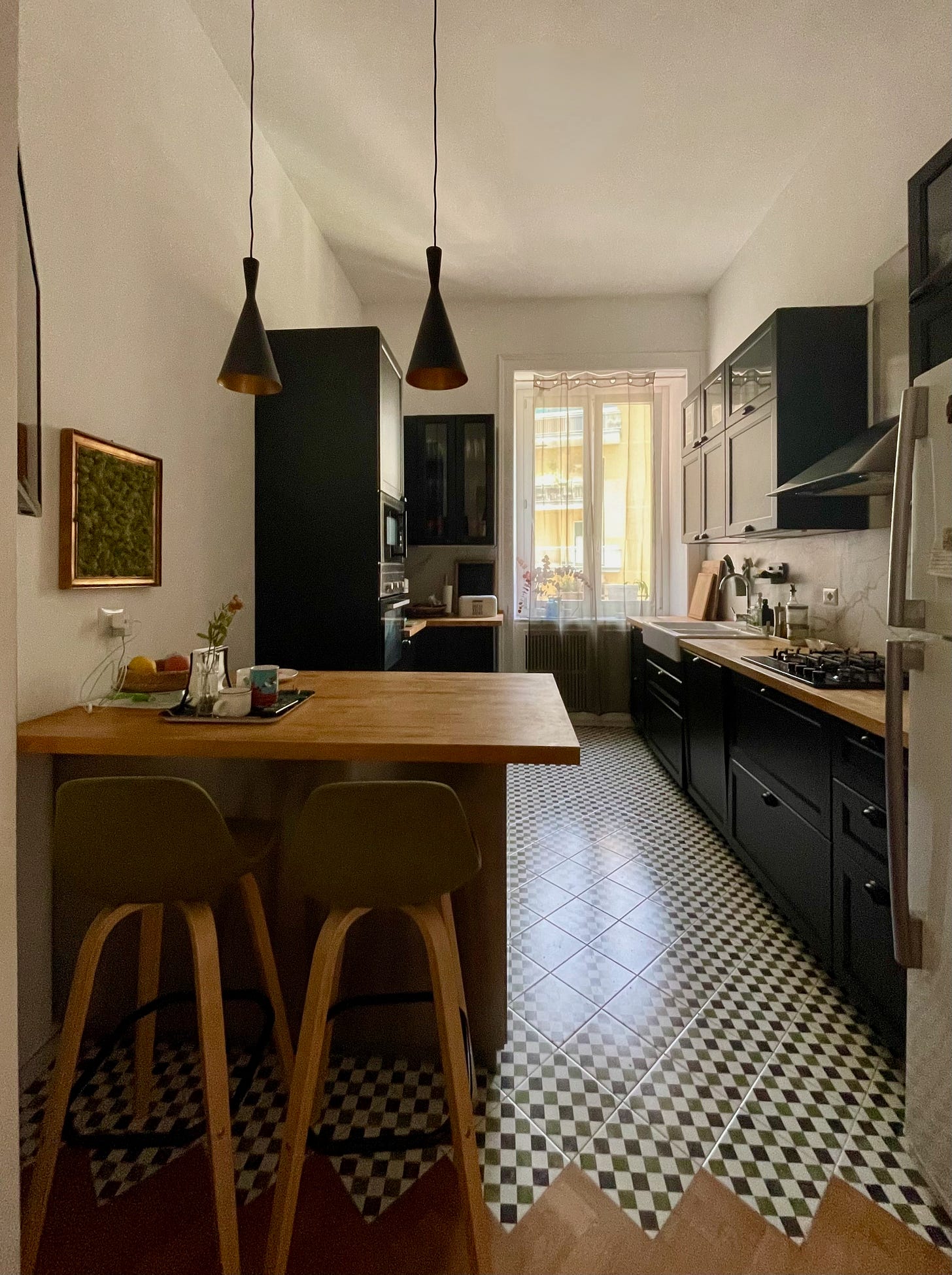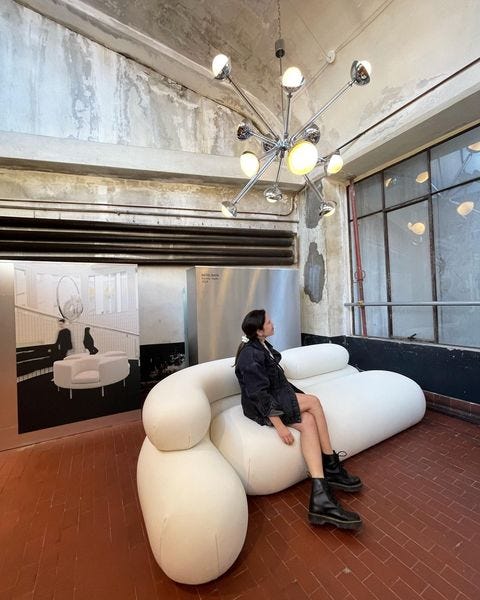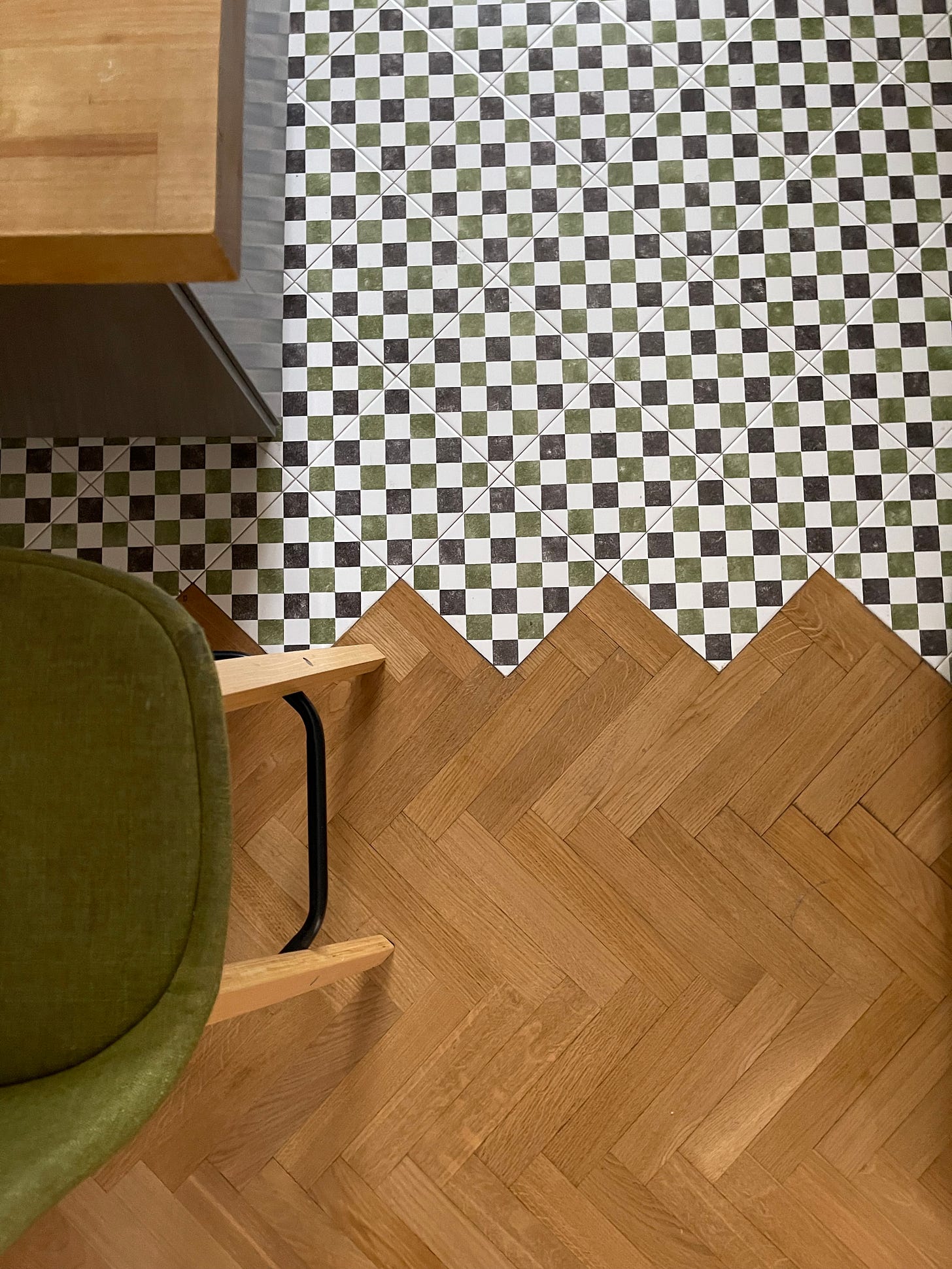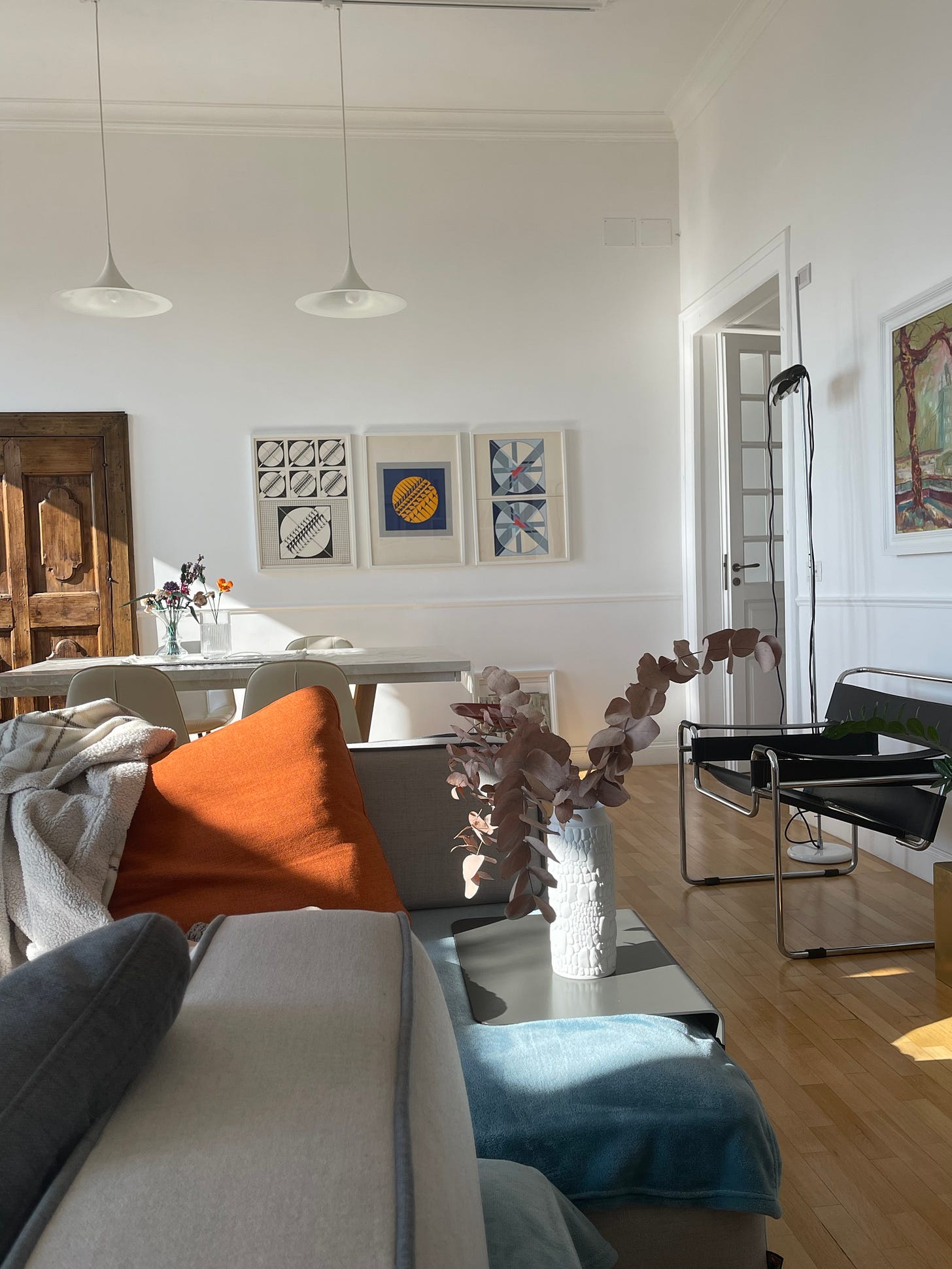Creative Living: Interview with Designer and Architect Marinella Rauso
Genius Loci, the spirit of place
As I am easing into my sabbatical, I’ve drawn inspiration from my friends around the world who are choosing to live creative lives. They may not follow traditional timelines or careers, but they’ve created something for themselves that is beautiful and fulfilling. Creative Living is a new series that interviews people who are making big moves to live more authentically. Our guest today is Marinella Rauso, an architect, designer, and creator who lives and works in Napoli, Italy. She’s also my good friend and has been kind to me since I moved to a new place.
Marinella inspires me because she has designed her life around expressing her creativity. It’s not just that she works in a creative field - she created art out of her life. I think we can all learn something from her.
I am proud to bring you my first bilingual interview! Read on for the original Italian.
How did you move from a traditional career in architecture to create something more aligned for yourself?
First of all, it was a question of need. The need to tell my vision - not only about architecture. Architecture is an all-encompassing experience. It’s not exclusively about making a beautiful home. A beautiful home meets the needs of its future inhabitants. It concerns aesthetics, understood as vision. It concerns ethics, understood as a set of values. The need to tell and create this idea of aesthetics and ethics, which responded to my need to communicate my vision, pushed me to leave the path within a large Interior Design studio and to find time and space to share a world that existed within me. In the beginning, it was shared through texts and images [on social media]. After a few years, it became real because several people, through my shared stories, have believed in my vision and have entrusted their heart’s “places” to me.
Tell us about your beautiful home in Napoli. What inspired you? How did you approach the project?
I think that when an architect designs their house, they bring their experiences into it: the houses they’ve lived in in the past, the places they’ve visited, the atmospheres they’ve dreamed of. And so I did. Already when choosing a home, I looked for space that had a history. The building where my apartment is located dates back to the 1920s. These buildings are my favorite because they have a distribution and spatial quality that tells you about the other lives they’ve lived. My challenge was to adapt it to contemporary living. I imagined a kitchen like a bistro, in aesthetics and ethics (understood as value), where one can tell each other stories. One evening a friend of mine said to me, “This kitchen is where you sit and confess. Where you feel good”. This is the quality I was looking for.
In the rest of the house, I had the same approach: respectful of the history, gradually adding the objects that the space seemed to require: Le Courbusier’s chaise lounge dreamed of in my early university years, the large tables for dining with friends, the fireplace that I define as “nostalgia for comfort” because it reminds us of happy times. The bookcase alternates pop objects and candles. The mini balcony with only green plants. The pianos. My house speaks about me. It has many voices and no one is screaming.
What are the outstanding features of Italian design? How do you incorporate that into your work?
When we talk about Italian design I think of the architects of the 50s and 60s. Designers like Gio Ponti, Castiglioni, Scarpa. In those times, design was a continuous discovery. It helped people improve their lifestyles and provided an aesthetic vision. I try to do this - not to give in to trends of the moment but to decline them every time.
You were not born in Napoli, but have lived here for over six years. How does life in Napoli impact your work?
I was born in Milan and studied in Rome. To those who ask me, “Where are you from?” I answer that I am Italian. I feel Italian because I was lucky enough to know three different realities. Napoli taught me to be with people, to listen more, and to understand other points of view. This translates into my work by being open to different visions. Not to impose a vision, but to listen to what the Latins called the “genius loci” - the spirit of a place.
You have many creative hobbies outside your profession: playing piano, walking, and learning new languages. How do you nurture your creative interests?
I’ve always thought of this phrase: “Creative people need time to sit and do nothing”. For those who have a profession officially recognized as creative, this summarizes well my need to focus on something else.
For example, right now, I’m answering this question that I haven’t been able to answer for weeks while sitting on the hydrofoil for Procida (a small island near Naples).
In reality, this “nothing” is our internal world. One that is not directly linked to that which you might produce but what pertains to the emotional sphere. Thought is the driving force of every project.
Going back to interests, everyone has a purpose. Walking, for example, helps me to focus on responses and solutions, without acting on instinct. I learned to not respond right away, most importantly when I found that the first response was too emotional - maybe because for some reason it touched me to the core.
To play piano is a way to lose myself. Cut ties with everything. Detach. Even if for a short while to restore myself.
Painting is the possibility to create something that relates well with my “interiors”.
And learning new languages satisfies the curiosity of hearing people’s voices directly. Hearing the voice means physically better understanding the universe that characterizes them.
To go back exactly to where I started, I would say that my creative interests arise from a need. Necessities that become refreshments and refuges.
ITALIANO
Come sei passato da una carriera tradizionale in architettura per creare qualcosa di più allineato a te stesso?
Prima di tutto è stata una questione di bisogno. Il bisogno di raccontare la mia visione. Non solo sull’architettura. L’architettura è un’esperienza totalizzante. Non riguarda esclusivamente progettare una ‘bella’ casa. Una bella casa che risponda alle esigenze dei futuri abitanti. Riguarda l’estetica, intesa come visione. E riguarda l’etica, intesa come insieme di valori. Il bisogno di raccontare e creare questa idea di estetica e etica, che rispondesse al mio bisogno di comunicare la mia visione, mi ha spinto ha lasciare il percorso in un grande studio di InteriorDesign, a trovare il tempo e lo spazio di raccontare un mondo che già esisteva. All’inizio era davvero quasi solo raccontando attraverso testi e immagini. Da qualche anno è diventato anche reale perché diverse persone, attraverso quei racconti, hanno creduto nella mia visione e mi hanno affidato i cuori ‘luoghi’.
Raccontaci della tua bellissima casa a Napoli. Cosa ti ha ispirato? Come ti sei avvicinato al progetto?
Penso che quando un architetto progetta la sua casa, ci porta dentro molto di quello che ha vissuto. Le case che ha abitato in passato, i luoghi che ha visitato, le atmosfere che ha sognato. E così ho fatto io. Già nella scelta dell’abitazione, ho cercato uno spaio che avesse una storia. L’edificio dove si trova il mio appartamento è degli anni’20. Sono i miei preferiti perché hanno una distribuzione e una qualità spaziale che ti parla di altre vite vissute. La mia sfida era adeguarlo all’abitare contemporaneo. Ho immaginato una cucina come un bistrot, nell’estetica e nell’etica (intesa come valore), dove raccontarsi. Una sera un mio amico mi disse “in questa cucina è dove ti siedi e ti confessi. Dove ti senti bene” e questa è una qualità che cercavo. Nel resto della casa ho avuto lo stesso approccio: rispettoso della storia, aggiungendo a poco gli oggetti che lo spazio sembrava richiedere. La chaise longue di Le Corbusier sognata dai primi anni di Università. Il grande tavole per cenare con gli amici. Il camino che definisco ‘nostalgia di comodità’ perché ricorda tempi felici. La libreria che alterna oggetti pop e candele. Il mini balcone con le piante solo verdi. Il pianoforti. La mia casa parla di me. Ha tante voci. Nessuna urlata.
Quali sono le peculiarità del design italiano? Come lo incorpori nel tuo lavoro?
Quando parliamo di Italian design penso agli architetti degli anni 50/60. I progettisti come Gio Ponti, Castiglioni, Scarpa. In quei tempi il design era una continua scoperta. Aiutava le persone a migliorare lo stile di vita e a offrire una visione estetica. Tento di fare ancora questo.Non cedere alle tendenze del momento acriticamente ma declinarle ogni volta.
Non sei nato a Napoli, ma vivi qui da più di sei anni. Che impatto ha la vita a Napoli sul tuo lavoro?
Sono nata a Milano e ho studiato a Roma. A chi mi chiede ‘ di dove sei?’ Rispondo sono Italiana. Mi sento italiana perché ho avuto la fortuna di conoscere tre realtà diverse. Napoli mi ha insegnato a stare con le persone. Ad ascoltare di più. A capire altri punti di vista. Questo trasporto nel mio lavoro significa essere aperta a visioni differenti. A non pensare d’imporre una visione ma ad ascoltare quello che i latini chiamavano il genius loci = lo spirito del luogo.
Hai multi hobby creativi al di fuori della tua professione: suonare il piano, camminare e imparare nuove lingue. Come coltivi i tuoi interessi creativi?
Ho sempre pensato che questa frase: “Creative people need time to sit and do nothing”, per chi ha una professione ufficialmente riconosciuta come creativa, sintetizzi bene la mia necessità di concentrarmi su altro.
Per esempio, adesso, sto rispondendo a questa domanda alla quale non riuscivo a rispondere da settimane, mentre sono seduta sull’aliscafo per Procida (una piccola isola vicino Napoli, per chi non fosse familiare con il luogo).
Quel ‘nothing’ è in realtà tutto il mondo intorno. Quello che non è direttamente collegato a ciò che devi produrre ma che afferisce alla sfera emozionale. Al pensiero, il motore di ogni progetto.
Tornando agli interessi, ognuno ha uno scopo.
Camminare, ad esempio, mi serve per focalizzare le risposte e le soluzioni, senza agire d’istinto. Ho imparato nel tempo a non rispondere subito, soprattutto quando trovo che la prima risposta sia troppo emotiva - forse perché per qualche ragione mi tocca nel vivo.
Suonare il piano è un modo per perdermi. Tagliare i ponti con tutto. Staccare. Anche se per poco e rigenerarsi.
Dipingere è la possibilità di creare qualcosa che si relazioni bene con i miei “interni”.
E imparare nuove lingue soddisfa quella curiosità di sentire la voce delle persone in maniera diretta. Dove sentire la voce significa sia fisicamente che comprendere meglio l’universo che li caratterizza.
Per tornare esattamente da dove sono partita, direi che che i miei interessi creativi nascono da un bisogno. Necessità che diventano ristori e rifugi.
What do you think? What has inspired you about Marinella’s approach to living a creative life? If you’d like to connect with Marinella, you can follow her on Instagram, check out her website, and connect with her on Twitter.
Don’t forget, I’m hosting a FREE journaling workshop this Sunday, Aug 18! We will spend an hour going through a few prompts together. Check out the event here, I’d love for you to join.














I love that you provided the interview in Italian as well. I’m trying to work on my fluency now that Italy is becoming home rather than just somewhere I love going on holiday.
And I’m in the process of furnishing our new house, so I loved her idea that a home contains elements of who you’ve been and where you’ve gone in the past.
Grazie Brenna, sono onorata di essere una tua amica. E di essere qui 🤍